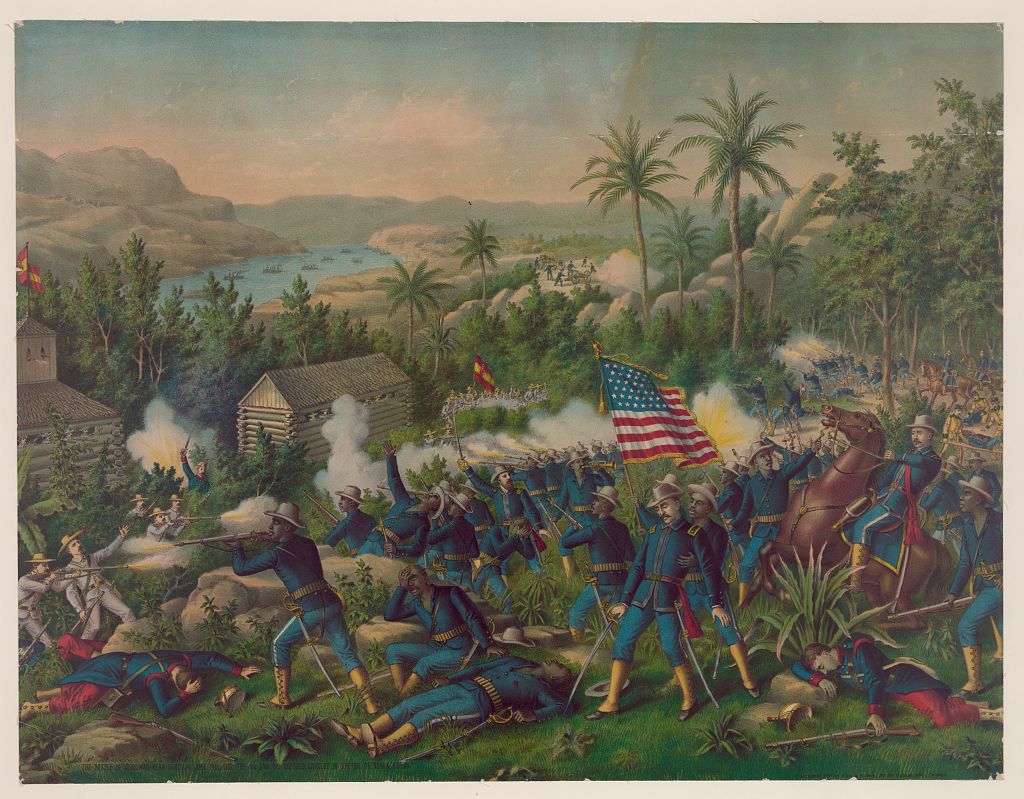Buffalo Soldiers in the Spanish-American War
By Sofie Barrett
The sinking of the battleship USS Maine in Havana Harbor, Cuba, on February 15, 1898, sparked the Spanish-American War. The explosion killed 268 men and sent shockwaves throughout the US as many Americans believed the Spanish orchestrated the incident. As Cuba fought for independence from Spain, this event proved to be a turning point in the escalating conflict between the United States and Spain. On April 25, 1898, Congress declared war against Spain.1
Of the over 17,000 men sent to Cuba to serve in the war, African Americans made up nearly 3,000 of the Regular Army soldiers. In order to prepare and train for the invasion of Cuba, all four regiments of Buffalo Soldiers (Ninth and Tenth Cavalry and Twenty-fourth and Twenty Fifth Infantry) trained in the South for the first time since their formation. Stationed in Tampa and Lakeland, Florida, these soldiers faced the harsh realities of segregation and the Jim Crow laws of the region.2
On June 6, 1898, mere days before the troops ventured overseas, a riot ensued in Tampa between white and black soldiers over the treatment of a two-year old black child. White soldiers from an Ohio regiment decided to hold a contest: whoever shot the little boy and put a bullet through his baggy shirt without harming him would win. Thankfully, the boy was not harmed, but when news of the event reached the black soldiers, violence broke out. At least twenty-seven black soldiers and three white volunteers received serious injuries and could not be deployed.3
On June 14, 1898, members of the Buffalo Soldiers travelled to Cuba to fight in the war. Due to the large number of men, horses, and artillery transferred to Florida, many soldiers stayed in the United States. Several companies remained behind to tend to the equipment and resources left on American shores because of the limited cargo space on the boats.4
Prior to their arrival in Cuba, the first major battle of the war had already occurred in the Pacific. On May 1, 1898, George Dewey and the US Asiatic Squadron defeated the Spanish fleet at Manila Bay in the Philippines. A month later, US troops including Buffalo Soldiers landed in Cuba. In July 1898, the US defeated the Spanish at the Battle of San Juan Heights (Kettle Hill and San Juan Hill), the most significant US land victory and the final major battle of the war. Troops of the Twenty-fourth Infantry and the Ninth and Tenth Cavalry fought their way up San Juan Heights alongside white regulars and the Roughriders⎯the First U.S. Volunteer Cavalry. Stories about their bravery and endurance during the fight made headlines. Future President Teddy Roosevelt, the leader of the Roughriders, praised the Buffalo Soldiers for their service and even stated during his vice-presidency campaign in 1900 that black soldiers saved his life in Cuba.5
The Twenty-fifth Infantry fought another battle in El Caney, north of San Juan Heights. This offensive proved crucial to the Spanish surrender of Santiago and allowed this regiment to be recognized for their bravery and fighting skills. Following the battles, the Twenty-fourth Infantry went on to serve in yellow fever hospitals due to the stereotype that African Americans could deal better physically with the tropical heat conditions in Cuba.6
The war’s turning point occurred when the US Navy destroyed the Spanish fleet off Santiago Bay, Cuba on July 3, 1898; on July 17, the Spanish Army in Santiago surrendered. On August 12, the US and Spain signed the Protocol of Peace, an unofficial treaty that ended the hostilities between the two countries. With the signing of the Treaty of Paris on December 10, 1898, Spain lost control of the remnants of its overseas empire ceding control of Cuba to the US while the US also received the territories of Puerto Rico, Guam and the Philippines from Spain. Cuba would be proclaimed an independent nation as an American protectorate. Puerto Rico and Guam would become US territories, and Spain agreed to sell the Philippines to the US for a lump sum of $20 million. This exchange of money and colonial rule started a longer and more deadly war⎯the Philippine-American War.7
As a result of the heroism and bravery displayed by the Buffalo Soldiers, these men received praise from blacks and whites alike upon their arrival home. Many homes became plastered with decorations of pictures of these regiments in battle. Despite the praise they received, it proved short lived. The same racism and discrimination continued after the war and these units remained segregated for almost fifty years after they charged up San Juan Heights.8
Additional Reading
Glasrud, Bruce A. Brothers to the Buffalo Soldiers: Perspectives on the African American Militia and Volunteers, 1865-1917. Columbia, MO: University of Missouri Press, 2011.
Tuccille, Jerome. The Roughest Riders: The Untold Story of the Black Soldiers in the Spanish-American War. Chicago, IL: Chicago Review Press, 2015.
Endnotes
1 Willard B. Gatewood, "Smoked Yankees" and the Struggle for Empire: Letters from Negro Soldiers, 1898-1902 (Urbana, IL: University of Illinois Press, 1971), 21.
2 "Buffalo Soldiers and the Spanish-American War," National Parks Service, February 28, 2015, accessed August 07, 2019, https://www.nps.gov/prsf/learn/historyculture/buffalo-soldiers-and-the-spanish-american-war.htm.
3 Willard B. Gatewood, Jr., “Negro Troops in Florida, 1898,” Florida Historical Society Quarterly 49, no. 1, (July 1970): 1-15, https://www.jstor.org/stable/30145817; Gatewood, "Smoked Yankees," 24.
4 Gatewood, "Smoked Yankees," 41.
5 "Battle of Manila Bay," History.com, November 09, 2009, accessed August 07, 2019, https://www.history.com/topics/early-20th-century-us/battle-of-manila-bay; Gatewood, "Smoked Yankees," 42-43; "Spanish American War: Topics in Chronicling America," Library of Congress, accessed August 07, 2019, https://guides.loc.gov/chronicling-america-spanish-american-war.
6 Frank N. Schubert, “Buffalo Soldiers at San Juan Hill,” Army.mil, November 19, 2010, accessed August 21, 2019, https://history.army.mil/html/documents/wwspain/buffalos_sjh/schubert.html; "Buffalo Soldiers and the Spanish-American War," National Parks Service.
7 "Spanish American War: Topics in Chronicling America," Library of Congress; "The Spanish-American War, 1898," U.S. Department of State, accessed August 07, 2019, https://history.state.gov/milestones/1866-1898/spanish-american-war.
8 "Buffalo Soldiers and the Spanish-American War," National Parks Service.
© 2019, University of Central Florida



